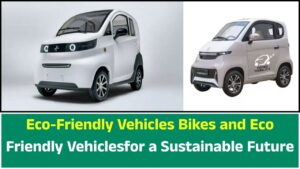Eco-Friendly Vehicles: Bikes and Eco-Friendly Vehiclesfor a Sustainable Future
1. Introduction to Eco-Friendly Vehicles
Transportation has always been a major contributor to environmental pollution. Traditional petrol and diesel vehicles emit carbon dioxide (CO2), nitrogen oxides, and particulate matter, causing global warming, air pollution, and health hazards. In response, eco-friendly vehicles have emerged as a sustainable alternative.

Eco-friendly vehicles are designed to reduce emissions, save energy, and use renewable resources. These include electric bikes, hybrid cars, solar-powered vehicles, and hydrogen fuel cell vehicles. The global shift toward eco-friendly transport is not just a trend—it’s a necessity for the survival of future generations.
2. Why the World Needs Eco-Friendly Transportation
- Climate Change: Fossil fuel-based transportation contributes nearly 24% of global CO2 emissions.
- Air Pollution: Cities face rising asthma, lung disease, and premature deaths due to vehicular pollution.
- Energy Crisis: Petrol and diesel are limited resources; dependence increases economic vulnerability.
- Cost Efficiency: Electric vehicles reduce fuel expenses significantly.
- Government Push: Many countries are setting targets to ban petrol/diesel cars in the coming decades.
3. Evolution of Eco-Friendly Bikes and Cars
- 1970s: First attempts at electric cars, but batteries were weak.
- 1997: Toyota launched the Prius, the world’s first mass-produced hybrid car.
- 2000s: Lithium-ion batteries boosted EV potential.
- 2010 onwards: Tesla revolutionized the EV market.
- 2020s: E-bikes became popular in Europe and Asia.
- Future: Solar cars and hydrogen fuel vehicles expected to dominate.
4. Types of Eco-Friendly Bikes
a) Electric Bicycles (E-Bikes)
- Battery-powered motor assists pedaling.
- Rechargeable, eco-friendly, affordable.
- Popular in cities like Amsterdam and Beijing.
b) Hybrid Bicycles
- Combination of manual pedaling and electric support.
- Suitable for both city commuting and long rides.
c) Solar-Powered Bicycles
- Solar panels charge the battery.
- Ideal for sunny regions, but costly.
d) Hydrogen-Powered Bicycles
- Fuel cells generate electricity from hydrogen.
- Still experimental, but highly sustainable.
5. Types of Eco-Friendly Cars
a) Hybrid Cars
- Combines petrol/diesel engine with an electric motor.
- Example: Toyota Prius.
b) Plug-in Hybrid Cars (PHEV)
- Can be charged via external electricity plus fuel.
- Example: Hyundai Ioniq Plug-in.
c) Fully Electric Cars (EVs)
- Run entirely on electricity.
- Zero tailpipe emissions.
- Example: Tesla Model 3, Tata Nexon EV.
d) Hydrogen Fuel Cell Cars (FCEVs)
- Use hydrogen gas to produce electricity.
- Example: Toyota Mirai.
e) Solar Cars
- Use solar panels for power.
- Still in early stages of commercialization.
6. Technologies Behind Eco-Friendly Vehicles
- Battery Technology: Lithium-ion, solid-state batteries.
- Charging Infrastructure: Fast-charging stations, wireless charging.
- Regenerative Braking: Converts kinetic energy back to stored energy.
- Lightweight Materials: Carbon fiber, aluminum for efficiency.
- Smart Connectivity: AI-assisted driving, vehicle-to-grid (V2G).
7. Eco-Friendly Bikes vs. Traditional Bikes
- Fuel Use: E-bikes reduce dependency on petrol-based two-wheelers.
- Speed: Slightly faster with motor assistance.
- Maintenance: Lower compared to petrol scooters.
8. Eco-Friendly Cars vs. Traditional Cars
- Emissions: EVs produce zero exhaust emissions.
- Running Cost: 70% lower than petrol cars.
- Noise Pollution: Quieter, smoother ride.
9. Benefits of Eco-Friendly Vehicles
- Environmental: Reduce greenhouse gases, conserve resources.
- Economic: Lower fuel cost, government subsidies.
- Health: Cleaner air reduces respiratory diseases.
- Social: Promotes sustainable urban living.
10. Challenges in Adoption
- High initial cost.
- Limited charging infrastructure.
- Battery recycling issues.
- Range anxiety (limited distance per charge).
11. Government Policies & Incentives
- India: FAME-II scheme, subsidies on EVs, tax exemptions.
- USA: Federal tax credits up to $7,500 for EV buyers.
- Europe: Bans on petrol/diesel cars from 2035.
- China: World leader in EV manufacturing and subsidies.
12. Major Brands in Eco-Friendly Bikes
- Hero Electric (India)
- Ather Energy (India)
- Yadea (China)
- Giant (E-Bikes, Taiwan)
13. Major Brands in Eco-Friendly Cars
- Tesla (USA)
- BYD (China)
- Tata Motors (India)
- Hyundai & Kia (Korea)
- Toyota (Japan)
14. Market Growth & Global Trends
- EV sales expected to quadruple by 2030.
- Europe and China lead adoption.
- India emerging as a growing EV hub.
15. Future of Eco-Friendly Transportation
- Solid-state batteries with longer life.
- Solar-integrated vehicles.
- Fully autonomous eco-friendly cars.
- Smart cities powered by green mobility.
16. Eco-Friendly Vehicles in Urban Planning
- Dedicated EV charging stations.
- Bike-sharing systems.
- Reduced traffic congestion.
- Smart public transport integration.
17. Role of Startups & Innovation
- Startups focusing on EV battery swapping.
- AI-driven ride-sharing platforms.
- Innovative designs for low-cost e-bikes.
18. Consumer Awareness & Education
- Campaigns promoting eco-friendly choices.
- EV exhibitions and expos.
- School & college programs about green transport.
19. Case Studies: Successful Eco-Friendly Vehicle Adoption
- Norway: 80% of new cars sold are EVs.
- China: Over 500,000 electric buses in operation.
- India: Rapid adoption of e-rickshaws in urban areas.
20. Conclusion
Eco-friendly vehicles are no longer futuristic dreams—they are today’s reality. From electric bikes for daily commutes to electric and hydrogen cars for long-distance travel, the shift toward green mobility is essential. Governments, industries, and individuals must work together to accelerate adoption. The journey to a pollution-free, energy-efficient, and sustainable transportation system begins with eco-friendly bikes and cars.
